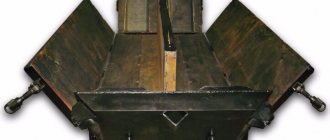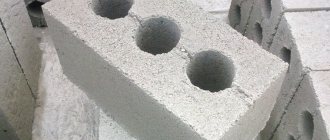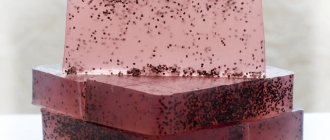Building structures made of wood concrete
Observing all the rules and following the instructions, nowadays you can make building blocks from sawdust with your own hands.
To make a building block correctly, the first step is to expose the sawdust to fresh air. Then, after four months of aging and treatment with calcium oxide, which you can independently make from 150-200 liters of a 1.5% solution per 1 m2 of raw materials, you can begin manufacturing from wood concrete.
In the production of wood concrete, one cannot do without a concrete mixer. M400 cement must be mixed with liquid glass, slaked lime, calcium sulfate and aluminum in a ratio of 3% of each cement additive.
Equipment
If the construction is large-scale, then it may make sense to spend money on equipment for building blocks. For example: there is a mini-machine for sale for the production of wood concrete RPB-1500 BL. Its productivity is 1 sawdust block with dimensions 19 x 19 x 39 cm per minute. Produced by a Russian manufacturer - INTEK.
Vibrating tables are widely used in the manufacture of building blocks. They solve the problem of compacting mixtures. The vibrating table consists of:
- movable table;
- engine;
- control panels;
- sometimes a transformer is included in the kit.
The compaction of the working mixture occurs under the influence of vibration created by a vibration motor.
Duty cycle
- place the mold on the movable table;
- place half or completely dry mixture into the mold;
- start the engine;
- drying.
How to choose?
There are 3 types of vibrating plates capable of compacting material by weight:
- up to 75 kg;
- from 75 to 160 kg;
- from 160 kg.
Based on these indicators, you should select the optimal vibrating table option for yourself.
Process Features
The shavings and sawdust must be soaked in water, then mixed with liquid glass, calcium chloride and slaked lime.
Then all the resulting mixtures must be mixed in a concrete mixer with cement and poured into pre-prepared molds, compacted manually with tampers.
How to pour concrete
The formwork is filled in parts. First, carefully fill about a third of the required volume with the solution, while the concrete must be stirred well and leveled with a trowel. Pay special attention to the solution in the corners. When adding subsequent portions of concrete, it is necessary to constantly level it and pierce it deep to remove trapped air and compact the composition. Finally, you need to level the top layer.
After the final filling of the formwork, try to make vertical grooves at the ends of the blocks. To do this, metal corners are used - press them with your hands to the end walls of the formwork and pierce the concrete mass along the entire height. When installing the blocks in their intended place, the grooves will be filled with mortar, and this will help the blocks to better adhere to each other.
After filling with concrete, the formwork is left for a couple of days. On the third day, the formwork can be removed, and the removed block can be left to dry for another 4 weeks so that it gains strength suitable for construction. Dry the blocks in natural conditions by covering them with roofing felt or placing them under an awning. During the first few days after you have made your own blocks, you should spray the resulting products with water to prevent them from cracking.
To speed up the production process and get more blocks in the same time, they try to build several formworks.
You can make not only foundation blocks, but also wall blocks with your own hands, only you need to choose slightly different sizes for formwork. Self-made FBS blocks can be used to build a garage or bathhouse, and for the walls of a residential building.
Expanded clay blocks
In order to make building blocks from expanded clay, you will need a trowel, a shovel, a bucket and containers of different sizes for mixing mixtures, as well as expanded clay, sand and water.
In this case, it is better to make a mold from boards, and cover its inside with either machine oil or tin.
Sizes and selection rules
Dimensions of blocks for building a house
State standards standardize the dimensional parameters of blocks for wall masonry. Standardization helps to correctly calculate the volume of material. The list includes solid stones or blocks with holes for communications.
Dimensions of wall elements:
- expanded clay concrete stones, solid and hollow - 40x20x20 cm;
- gas silicate - 60x25x40 cm and 60x25x50 cm;
- foam concrete - 60x30x25 cm and 60x40x20 cm;
- polystyrene - 60x30x25 cm and 40x20x20 cm;
- wood concrete - 15x20x50 cm, 20x20x50 cm and 30x20x50 cm;
- ceramic - 25x12x6.5 cm, 25x12x14 cm, 25x25x14 cm, 51x9.5x22 cm.
When choosing materials, their cost and thermal conductivity, as well as labor costs for the construction of vertical structures, are taken into account. They take into account the need for insulation, waterproofing and decorative finishing, which will entail costs. What matters is the strength and load-bearing characteristics of the finished wall, its fire hazard, saturation with moisture and environmental cleanliness.
Correct casting of the mixture
Mix all the ingredients with water and stir until the desired consistency, then pour into the mold and compact.
After a couple of days, the block can be removed from the mold and sent to dry for a month. The price will be approximately 22.5 rubles per piece, since a regular block of 15-18 kilograms will consume 1-2, 4 and 10-11 kilograms of cement, sand and expanded clay, respectively.
Application of polystyrene concrete
A type of lightweight concrete, polystyrene concrete, today successfully competes and sometimes displaces expanded polystyrene, as well as aerated concrete. Possessing good rigidity, heat and sound insulation characteristics, these lightweight blocks can be used for:
- Masonry of external walls of the house.
- Creation of partitions on the upper floors in buildings where, due to the weakness of the floor slabs, it is impossible to use heavier materials, for example, cinder block.
- An additional layer of insulation and sound insulation (this is possible when making polystyrene blocks when pouring formwork).
- Construction of premises where it is necessary to maintain certain temperatures (baths, saunas).
In practice, there is no ban on the use of this material. It fits everywhere. You just need to focus on its thermophysical indicators. So, expanded polystyrene has:
- Density (marked with English D). The minimum indicator is 150, the maximum is 600. Polystyrene concrete is close in this indicator to cinder block. But still inferior to him. Therefore a solid 4.
- Compressive strength from 0.2 MPa to 10 MPa. Strong enough, but no stronger than real concrete. Considering that its service life is more than 10 years, an honest rating of 3.
- Thermal conductivity: minimum 0.05, maximum 0.14 W/m°C. This indicator for polystyrene foam is one of the highest compared to other building materials. Solid 5.
- Frost resistance (marked F). Maximum - from 100 (but then this material will not be so warm), minimum 15. Frost resistance is average. 4 (and it’s a stretch).
- Operating humidity 4 – 8% by weight. Polystyrene concrete repels moisture. But the walls in the steam room must be finished from the inside, because otherwise it will let it through. Rating – 4.
Overall, the average score is 4. Polystyrene concrete is a good building material that is not only easy to use, but also quite simple to manufacture.
Polystyrene concrete blocks in construction:
Aerated concrete blocks
Aerated concrete blocks will require calcium oxide, a hydraulic binder, as well as sand, water and some aluminum powder.
Tools that will be useful are a concrete mixer, a shovel and buckets. It is also mandatory to ensure the availability of personal protective equipment.
Quicklime, hydraulic binder, quartz sand, aluminum powder and water are mixed in a mixer at 20, 20, 60, 1 and 9 percent respectively.
The resulting mixture must be poured halfway into a metal or plastic mold for 5-7 hours, then cut into pieces of the required size, removed and left to dry and gain strength.
One day of drying indoors is enough for them to be stacked on top of each other. In exactly one month, the aerated concrete blocks will be suitable for construction.
Making aerated concrete with your own hands
Producing aerated concrete at home requires some tools. You need to prepare:
- grinder with disc;
- wood hacksaw;
- electric drill;
- plane;
- hacksaw for working on metal;
- sharp knife;
- plumber's hammer;
- shovel for mortar;
- mixer for mixing the mixture;
- ruler;
- construction hair dryer;
- Master OK,
- steel string for cutting blocks;
- putty knife;
- scales;
- chisel and chisel;
- measuring bucket
Using a measuring bucket and scales, the necessary components for the solution are measured. The production of gas blocks is carried out from the following components:
- Portland cement grade M400-M500 - 50-70%;
- sifted quartz sand - from 20 to 40%;
- lime as a plasticizer - 1-5%;
- aluminum powder or paste - 0.04-0.09%;
- water - 0.25-0.8%.
Collapsible metal mold
Pouring lightweight concrete
Removing excess concrete mortar
Blocks after stripping
The mixture is thoroughly mixed and laid out in forms, which come in different shapes. This can be a pretty durable box. Its height is equal to the height of the blocks. The total volume is 4-9 gas blocks. The molds can be made of wood or metal. It is advisable to make the structure collapsible. A more complex option is a box with cells, which can be made of wood 30-40 mm thick, or metal 4-6 mm thick. Internal partitions can be made of plywood. Its thickness should be 12-15 mm. Before pouring the solution, the surfaces from the inside must be lubricated with technical oil and the entire structure must be heated with a hairdryer to 40˚. The mixture is poured to the level of half the height of the box. The remaining space will be filled as the composition expands and pores form.
The gas release reaction lasts 6-8 minutes. The solution first rises, then shrinks slightly. After shrinkage, you can cut off the top part with the prepared string and remove the blocks from the mold. Cooling of the blocks should occur under natural conditions. The use of fans is not recommended. It is recommended to install the mold on a flat horizontal surface. It is better to prepare several boxes at once in order to mix a significant amount of solution. The work site must be sheltered from wind and precipitation. The block sizes can be chosen at your own discretion.
Features of storing cinder blocks
Often, cinder blocks are stacked in pyramidal stacks of 100 pieces, leaving a small distance between them.
After about a couple of months, when they harden, they can be used to build a house, bathhouse or barn.
Read on to find out more!
Basement and foundation waterproofing
What do you need to know before laying the foundation?
Driving piles
Where to buy reinforcement for the foundation
House foundation price
Columnar foundation
- 2.69
Rating: 2.7 out of 5 Votes: 139
- 1
Reply
6 years ago
Some practical tips for making cinder blocks
Building structures made of cement are considered the most durable.
To prevent anything from sticking to the walls of the mold, before each pour you need to wipe the walls and bottom of each mold with diesel fuel.
If sifted sand is used instead of fine granules, stronger building structures will be obtained.
The thicker it is, the less drying time it takes.
You can reduce the cost without losing quality if you mix cement with lime in a ratio of 3 to 1.
If you are interested in renting a jcb backhoe loader, SpetsTekhnika24 is always happy to help in solving any problems.
Necessary materials
For a building material, strength has always been one of the most significant qualities. But using only cement and sand will make the production of concrete blocks unprofitable; the blocks are expensive.
The way out of this situation is to use additional types of raw materials as fillers as the main materials for production. Such fillers make it possible to obtain products with additional qualities - lightness and reduced thermal conductivity.
To prepare concrete mortar the following are used:
- Cement grade 400 or 500;
- Natural filler;
- Plasticizers;
- Water.
Cement is preferable to grades 500 and 400; it is not only the most popular, but also the most suitable material for preparing the mortar formulation. All recipes recommended for preparing concrete are based on the proportions of this particular group of cement.
The filler used is:
- River or quarry sand;
- Crushed granite stone of small and medium fraction;
- Granite screening;
- Granular slag;
- Sawdust and shavings;
- Expanded clay;
- Products of processing of concrete products and broken bricks;
- Chemical fillers used for the manufacture of insulation;
- Blast furnace slag.
Preparation of a concrete mixture requires the correct dosage of cement and proportions of filler. For high-quality concrete wall elements of load-bearing walls, the following proportions are taken:
- Cement - 1 measuring part;
- Filler - 7-9 measuring parts;
- Water - 1/2 measured part of cement;
The plasticizer is not used under normal temperature conditions, when the air temperature is stably above +15 degrees. When the temperature drops, when drying in unheated rooms or outdoors, adding a plasticizer is desirable, but if the temperature does not drop below +5, it can not be used. At temperatures below +5, such a plasticizer must be used.
To obtain concrete, the use of a plasticizer must be as precise and dosed as possible. Most additive manufacturers recommend adding 5 grams per conventional block volume.










